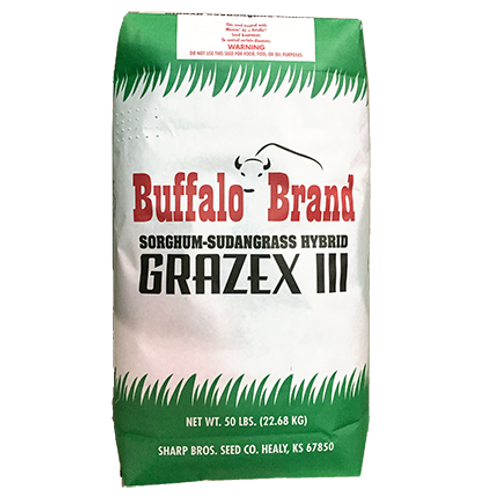Outstanding Forage Quality Sorghum Sudangrass Hybrids
These hybrids, resulting from a cross of sorghum with sudangrass are best suited for in season grazing or multi-cut haying or haylage (immature plant silage). Excellent regrowth after clipping. Excellent seedling vigor. Somewhat better iron chlorosis tolerance and slightly better cold seedbed tolerance than forage sorghum. Minimum germination soil temperature of 60 degrees and rising. Maximum planting depth 2 ½ inches. Late season leaf retention is poor compared to forage sorghums, making sorghum sudangrass less suited for post season grazing or mature plant silage.
- Grazex Bale Spear Palatable
- Excellent track record for staying green during drought
- Vigorous Recovery after drought
Uses, Strategies & Suggested Planting Rates:
Multi Cut Baled Dry Hay, Haylage
Production goal --- Fine stems for quick dry down in the windrow and tight weather resistant bales or easily packed haylage. High plant populations produce the finest stems; low plant populations have the best drought tolerance. Producers should find the best compromise between these competing goals for their cropping conditions. Narrow rows (grain drills) are preferable to wide rows (row crop planters).
Western Dryland 12-20 lbs/acre Eastern Dryland/ Irrigated 18-28 lbs/acre
In Season Grazing
Production goal--- Fine stemmed, leafy dense growth contributes to maximum efficiency grazing. Initiate grazing when sorghum sudangrass is 24 inches tall, 4 to 5 weeks after emergence with good growing conditions.
Western Dryland 12-20 lbs/acre Eastern Dryland/ Irrigated 18-28 lbs/acre
Late Summer Mixed Planting with Winter Annual Small Grains for Fall Grazing
Sorghum sudangrass seed can be added to winter annual small grains (wheat, rye, triticale or barley) seedings to increase fall grazing at an earlier date. This is most productive with plantings in August or early September. Producers have effectively mixed these seeds by adding sorghum sudangrass seed to cereal grain seed as it is augered into the seed tender. Cattle should be turned out to graze when sorghum sudangrass is 24 inches tall, approximately 4 weeks after seeding. Producers report that the partial shade created by the sorghum sudangrass does not noticeably restrict small grain development. If sorghum sudangrass is still present as the first freeze is predicted, cattle should be removed from the field until frozen sorghum sudangrass plants have dried, allowing prussic acid to evaporate, usually 4 to 7 days. New tillers are unlikely to be produced from the small crowns typical of late summer plantings, but if they do occur, prussic acid levels could be high.
Western Dryland 6-10 lbs/acre Eastern Dryland/ Irrigated 8-12 lbs/acre
Sudangrass Cover Crop Preceding Perennial Grass Seedings
Coarse stems are important to create durable cover since stems generally stay in place through the following winter and spring as compared to leaves which frequently blow away.
Western Dryland 6-10 lbs/acre Eastern Dryland/ Irrigated 8-12 lbs/acre





